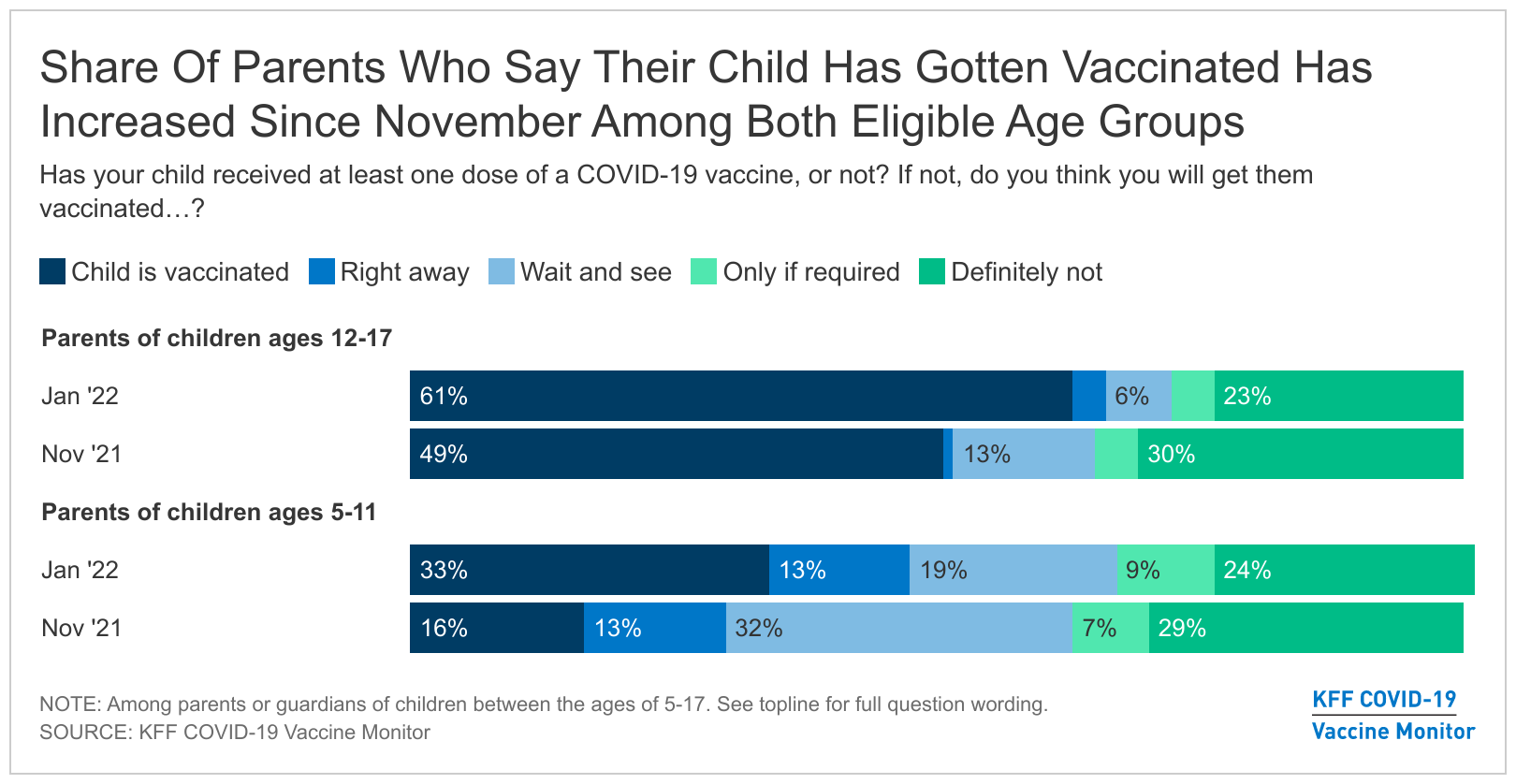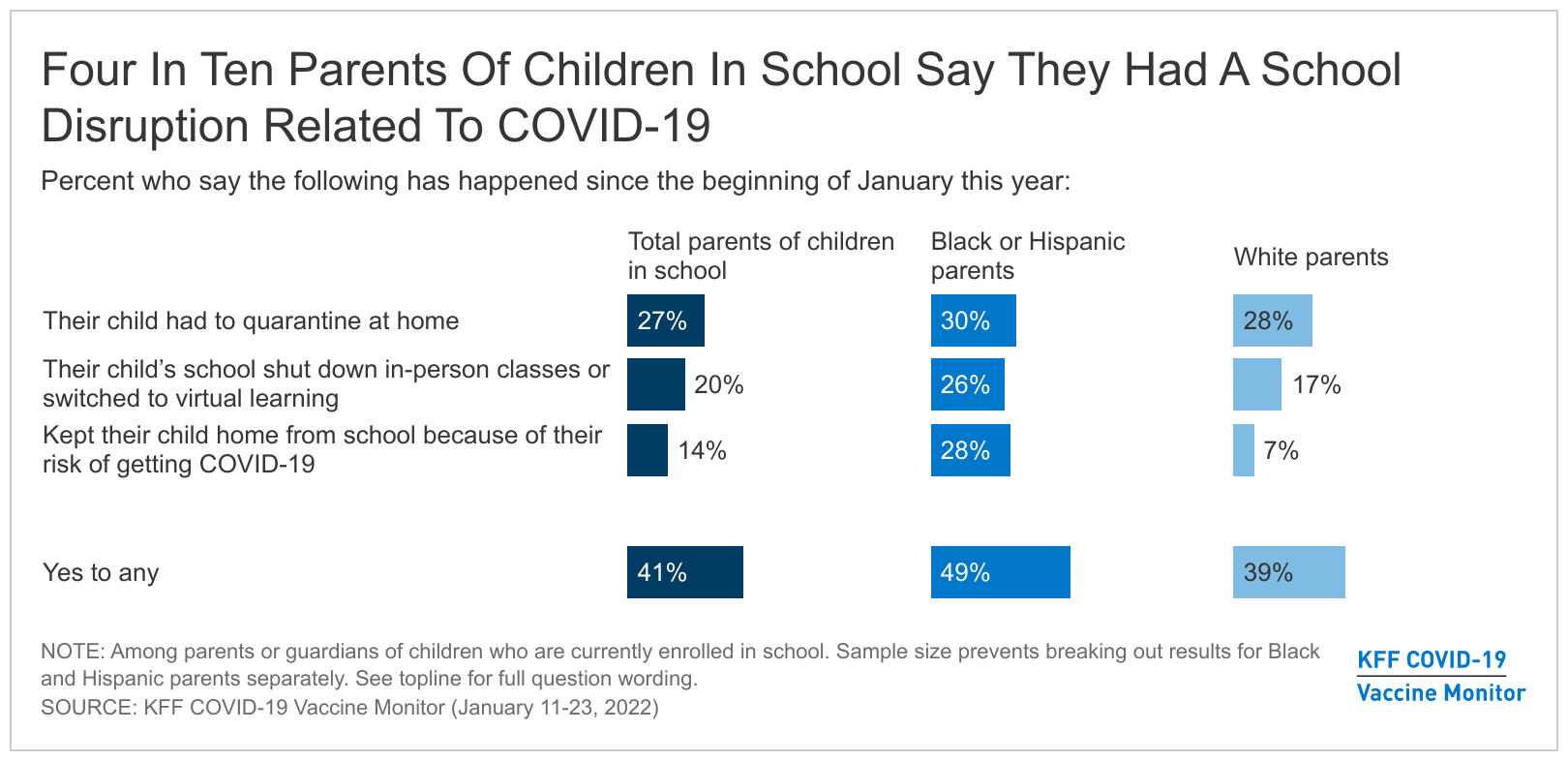
The independent source for health policy research, polling, and news.
Vaccine Monitor: 6 in 10 Parents of Teens and One-Third of Parents of 5-11 Year-Olds Say Their Child is Vaccinated for COVID-19, Both Up Since November
3 in 10 of Those with Children Under 5 Expect to Get Them a Shot Right Away Once Eligible
1 in 4 Parents Say Their Student Had to Quarantine in January Due to COVID-19 Infection or Exposure; Overall 4 in 10 Report Some Education Disruption
Growing shares of parents say that their eligible children have gotten at least one dose of a COVID-19 vaccine, and three in ten parents with children under age 5 say they want to get their child vaccinated immediately once they become eligible, a new KFF COVID-19 Vaccine Monitor report shows.
Among parents with children ages 12-17, 61% now say that their child is vaccinated, up from 49% in November. Another 3% now say they plan to get their child vaccinated as soon as possible, and 6% say they want to “wait and see” how it works for others before doing so. Nearly a quarter (23%) of parents with adolescent children say they definitely will not get them vaccinated, while a small share (4%) say they will only do so if it is required for school.
Adolescents and teenagers in this age group are also encouraged to get a booster shot six months after their initial vaccination. One in five (21%) parents with vaccinated children in that age range say their child has already received a booster, while most others say they definitely (41%) or probably (24%) will get them a booster shot.
Among parents of children ages 5-11, who became eligible for a COVID-19 vaccine in early November, a third (33%) say their child is now vaccinated, twice the share that said so in November (16%). In addition, 13% now say they want to get their child vaccinated “right away”, and 19% say they want to “wait and see” before doing so. Others are more resistant, with a quarter (24%) saying they “definitely will not” get their child vaccinated and 9% saying they would “only do so if required for school.
While children under age 5 are not yet eligible to receive any COVID-19 vaccine, three in ten (31%) parents of children that age say they would get their child vaccinated “right away” when able. A similar share says they would want to “wait and see” how it works for other young children first, while a quarter (26%) say they would “definitely not,” and 12% say they would do so “only if required.

Since schools reopened in January after the holidays, more than a quarter (27%) of parents say their child has had to quarantine at home because they tested positive for COVID-19 or were exposed to someone who tested positive, the new Vaccine Monitor survey finds.
In addition, one in five parents (20%) say their school shut down in-person classes or switched to virtually learning at some point in January, and 14% say they kept their child home from school because of the risks of getting COVID-19.
Combined, 41% of parents report at least one of those three types of disruption with their child’s education. This includes half (49%) of Black and Hispanic parents, who are much more likely than White parents to say they kept a child home from school because of the COVID-19 risks (28% and 7%, respectively).
Overall half (50%) say they are worried their child will get seriously ill from COVID-19, including a quarter (25%) who say they are “very worried.” Black and Hispanic parents are also much more likely to be worried about this than White parents (70% and 39%, respectively).
Other findings include:
- About one in seven (14%) parents of unvaccinated children ages 5-17 say that news about the omicron variant makes them more likely to get their vaccinated, while a large majority (79%) say that it makes no difference.
- 3 in 10 (30%) parents of children enrolled in school say their child’s school provided COVID-19 tests for students to take either in person or at home before returning to school after the winter holidays. In addition, about 4 in 10 (39%) parents of children enrolled in school say they tried to purchase an at-home test kit in the past month.
Designed and analyzed by public opinion researchers at KFF, the KFF Vaccine Monitor survey was conducted from January 11-23, 2022 among a nationally representative random digit dial telephone sample of 1,536 adults, including 420 parents or guardians of children under 18. Interviews were conducted in English and Spanish by landline (165) and cell phone (1,371). The margin of sampling error is plus or minus 3 percentage points for the full sample, and plus or minus 6 percentage points for parents of children under 18. For results based on subgroups, the margin of sampling error may be higher.
The KFF COVID-19 Vaccine Monitor is an ongoing research project tracking the public’s attitudes and experiences with COVID-19 vaccinations. Using a combination of surveys and qualitative research, this project tracks the dynamic nature of public opinion as vaccine development and distribution unfold, including vaccine confidence and acceptance, information needs, trusted messengers and messages, as well as the public’s experiences with vaccination.
